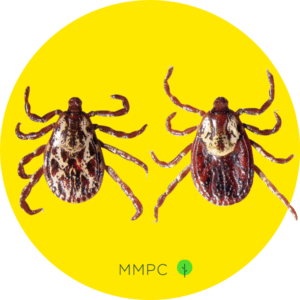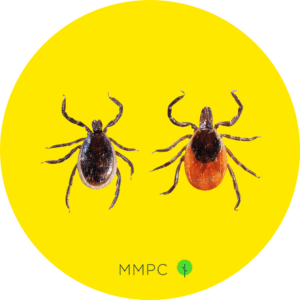
If a tick has bitten you or your pet, being able to identify its species can be very helpful. We recommend preserving the tick in a container and taking it to your healthcare provider or veterinarian, so they can diagnose any ensuing symptoms.
In less urgent situations, you can also take a picture of the specimen, send it to our free Pest ID Center, and have the tick experts at MMPC help identify it for you.
What Do Ticks Look Like?
Ticks are tiny arachnids that survive by feeding on a host’s blood. They belong to the same class of joint-legged invertebrates as mites and spiders. The physical characteristics such as size, appearance, and color patterns of ticks vary according to their species and gender.
Ticks have a distinct appearance before and after feeding. Prior to feeding, they resemble small, wingless bugs with flat bodies shaped like ovals or teardrops, and have eight legs. However, once they attach themselves onto a host, their bodies expand and become several times larger depending on the amount of blood ingested.
Only female ticks feed on hosts and spread disease. Male ticks can also bite, but they don’t engorge themselves like females do. They might attach themselves to a host and feed briefly before detaching themselves to wander off in search of a female to mate with. Therefore, most tick-borne diseases (such as Lyme disease) are transmitted by female ticks.
In the section below, we’ll explain the basic anatomy, size, shape, and color of ticks to help you understand what they look like and how to identify them.
Anatomy
- 8 legs, each with 7 segments and curved claws at the tips
- No wings
- No antennae
- A small head called the capitulum
- A prominent set of mouthparts consisting of palps, chelicerae and hypostome
- An oval-shaped body called the idiosoma
- A dark-colored, hardened plate on its back called the scutum
You can tell female ticks apart from male ticks by examining the scutum on their back. Female ticks have a relatively small scutum (covering only about 1/3 of their back), which allows their bodies to expand when feeding. Male ticks have a large scutum that covers their entire back.
Most ticks also have distinctive color patterns on the scutum which helps identify their species.
Size
- Adult ticks are usually between 2–6 mm long.
- Nymphs are between 1–2 mm long.
After feeding, a female tick becomes engorged and its size can grow by several times (up to approximately 10–15 mm). In contrast, a male tick doesn’t increase in size after feeding.
Shape
- Viewed from the top, ticks have an oval or teardrop shape.
- Viewed from the side, ticks are flat (before feeding).
- After feeding, female ticks take on a globular, engorged shape resembling a coffee bean.
Color
- Depending on the species, the color of ticks can vary.
- They can be black, brown, reddish-brown, gray, or yellow.
After feeding, female ticks may change colors in their engorged state. For example, an engorged deer tick turns reddish-brown or rust-colored, while an engorged dog tick turns gray or grayish-blue.
Common Ticks in New York
There are approximately 90 species of ticks in the United States. The most common types of ticks found in New York include:
What Do Blacklegged Ticks (Deer Tick) Look Like?
The blacklegged tick, also known as the deer tick, is the smallest species of ticks in the United States, reaching only 3 mm as fully-grown adults.
This species can also be identified by its distinct color. Adult female blacklegged ticks have an orange-red body and a black scutum. Their legs are also dark, matching the color of their scuta.
The blacklegged tick is the only type of tick that transmits Lyme disease.
What Do American Dog Ticks Look Like?

The American dog tick, sometimes referred to as the wood tick, are larger than deer ticks and adult females can grow up to 5 mm in size.
This species can be recognized by the white markings on their bodies. Female American dog ticks have white markings primarily on their scuta, while males have white markings across their entire back.
What Do Lone Star Ticks Look Like?

Female lone star ticks can be identified by the conspicuous white or yellow spot on the middle of their backs. The males have smaller, less prominent markings around their festoons (the small areas separated by grooves located on the back end of the tick).
Where Do Ticks Live?
Ticks are most prevalent in wooded areas and grasslands. They prefer cooler areas where trees, brushes, leaves, and tall grasses provide cover from the sun.
It’s important to note that ticks can also be found in urban areas, such as parks and gardens, and can be carried by a number of wild animals, including deer and rodents.
Need Help Identifying Ticks?
Just send a picture to our free Pest ID Center. The pest experts at MMPC can help you determine what type of tick you’ve found.

